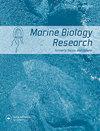Harpinia Boeck属的第一个记录,1876年(两栖目:Phoxocephalidae:Harpininae),来自南半球,描述了三个新种
IF 1.2
4区 生物学
Q4 ECOLOGY
引用次数: 0
摘要
在巴西东北部发现了3个新种,首次记录了该属在南半球的分布。所检查的材料是在“avalia本文章由计算机程序翻译,如有差异,请以英文原文为准。
First record of the genus Harpinia Boeck, 1876 (Amphipoda: Phoxocephalidae: Harpiniinae) from the southern hemisphere, with description of three new species
ABSTRACT Three new species of Harpinia are described from north-eastern Brazil, documenting the first record of the genus from the southern hemisphere. The material examined was collected using a Mini Box Corer within the project ‘Avaliação da Biota Bentônica e Planctônica da Bacia Potiguar e Ceará’ in Potiguar Basin, Rio Grande do Norte state, from depths ranging from 283–998 m. Harpinia bidens sp. nov. is characterized by the following: head with dorsal keel; antenna 2 peduncle article 1 weakly ensiform; gnathopod 2 palm defined by a large excavation producing a spine; epimeral plate 1 posteroventral corner as a short blunt lobe; and epimeral plate 3 with an oblique facial row of setae, posteroventral corner as a large spine. Harpinia kingae sp. nov. can be diagnosed by the following: antenna 2 peduncle article 1 ensiform; gnathopod 1 palm defined by a u-shaped excavation; coxa 7 posterior margin crenulate; epimeral plate 3 posteroventral corner as a spine; and uropod 2 outer ramus with subapical nail. Finally, H. longidactyla sp. nov. has the following diagnostic characters: head with lower lateral blunt projection; antenna 2 article 1 not ensiform; gnathopods 1–2 palm defined by a sinuous excavation; pereopod 6 dactylus longer than propodus; and epimeral plate 3 posteroventrally rounded. Also, a discussion about the genus and an identification key to world species of Harpinia are provided.
求助全文
通过发布文献求助,成功后即可免费获取论文全文。
去求助
来源期刊

Marine Biology Research
生物-海洋与淡水生物学
CiteScore
2.10
自引率
0.00%
发文量
55
审稿时长
6-12 weeks
期刊介绍:
Marine Biology Research (MBRJ) provides a worldwide forum for key information, ideas and discussion on all areas of marine biology and biological oceanography. Founded in 2005 as a merger of two Scandinavian journals, Sarsia and Ophelia, MBRJ is based today at the Institute of Marine Research, Bergen, Norway. The Journal’s scope encompasses basic and applied research from all oceans and marine habitats and on all marine organisms, the main criterium for acceptance being quality.
 求助内容:
求助内容: 应助结果提醒方式:
应助结果提醒方式:


